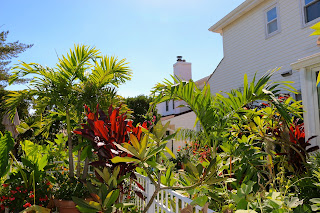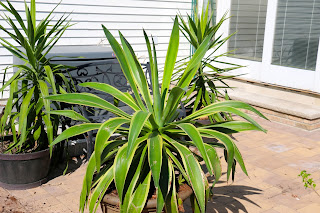Ferns are one of the most versatile plants in the world. Where there is water there are bound to be ferns somewhere! Some grow in trees in the tropics and subtropics, others grow as trees providing a beautiful canopy in exotic forests and beautiful gardens, and the rest grow close to the ground. Here are some photos of my ferns. I have a few species of ferns not included in this post because they are young and not as photogenic. I'll make a separate post for those soon!
Here is my Staghorn fern. It's an epiphyte which means it gets its nutrients from the air and does not grow in soil. Because of this you can do lots of cool things with them like mount them on a piece of driftwood, hang them from a tree (or mount them to trees like they grow in the wild if you live in a warm climate). I have mine is growing in a tiny glass pot which makes it look really interesting. It grew FAST this summer and the plant is now swallowing the pot. I'll be repotting it in the spring for sure if I can keep it happy inside my house this summer. I have no idea how I will manage to repot it so stay tuned in the spring for that!
I just brought my Staghorn Fern inside today. It's going to spend the winter in my bathroom where it should be happy. It's got a skylight so there is plenty of natural light and it is of course pretty humid in there. We will see how it holds up!
This next fern is the most common fern growing in yards around here. In cooler climates they can handle some full sun but in my yard they definitely are lovers of the shade. They can actually get pretty large. Unfortunately they do lose their leaves in the winter. Ostrich Ferns are their name if you want to get your own. I warn you that they are a little weedy but they are native! I have them growing in a confined bed so it doesn't act up. The light green fronds are called sterile fronds and make up the majority of the plant. The funky looking fronds in the center of the plant are called fertile fronds and that is how this fern species releases its spores to reproduce. Ferns have been around for a VERY long time so they are sometimes a bit weird and primitive which makes them all the more interesting to grow.
Here's my newest fern planted this past spring. It's called a Tassel Fern (Polystichum polyblepharum) and it is reported to be evergreen in my climate. There are not a lot of evergreen fern options for my area so I think this will be a really valuable addition to my landscape. It'll definitely add some tropical vibes to the winter garden.
I am very surprised that it is growing this time of the year. I wonder if the new, tender growth will survive a hard freeze.
The "trunk" reminds me a lot of a young tree fern. The fronds do too actually. This is a very tropical looking fern. Not sure if it will prove to be evergreen but it is reportedly hardy down to -20F so it will definitely survive the winter if that is true. Looking forward to finding out!





































